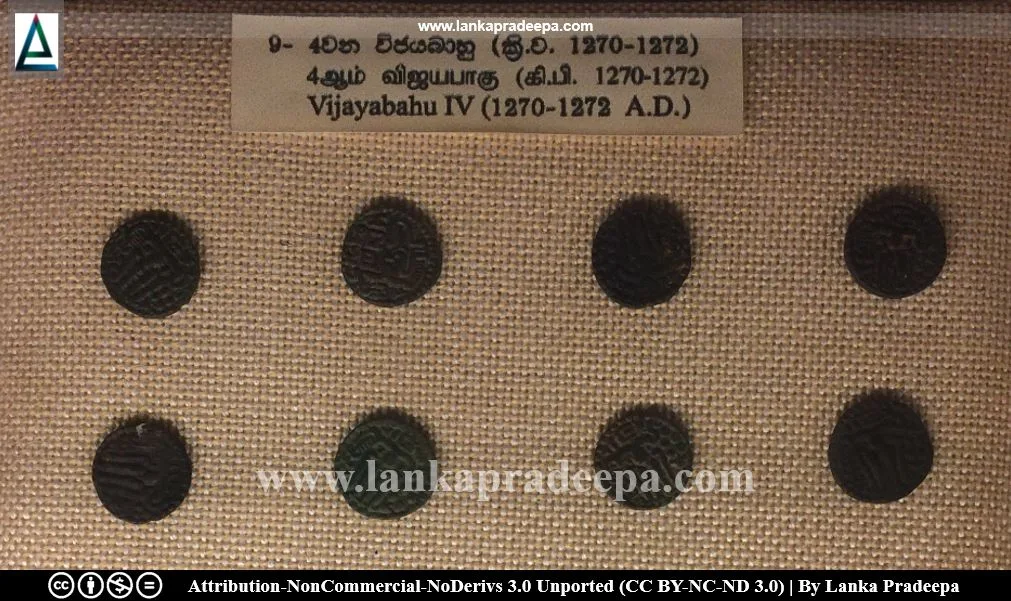
Vijayabahu IV (Sinhala: හතරවන විජයබාහු රජ; Tamil: நான்காம் விஜயபாகு) was the King of Dambadeniya Kingdom, Sri Lanka from 1270 A.D. to 1272 A.D. He ruled the country from the capital at Dambadeniya until he was assassinated by a general named Mitta (Ray, 1960). He had the surname of Bodhisattva and was a mild and humane in character (Ray, 1960).
Reign
The king of Dambadeniya
Vijayabahu IV succeeded to the throne after the death of his father Parakramabahu II [(1236-1270 A.D.) Ray, 1960]. However, he had control of the affairs of the state for several years before his father's death (Ray, 1960). In 1262, he and his cousin Virabahu attacked and defeated Chandrabanu, a Javaka invader from Tambralinga.
Mitta's conspiracy and the death of Vijayabahu IV
A general named Mitta assassinated Vijayabahu IV through a slave in the second year of his reign (Ray, 1960). Buvanekabahu, the younger brother of the king was also on Mitta's assassination list but he managed to escape from it as he finally could reach the Yapahuwa Fortress which was not on the side of the conspirators (Ray, 1960).
Arya's loyalty
General Mitta, in the meantime, seated on the throne as the ruler of the country. On the advice of his supporting dignitaries, he arranged some payments to the soldiers in the royal army to win over their loyalty (Ray, 1960). The royal army which consisted of the Sinhalese and Aryas (Rajputs from North India) was offered payments and only the Sinhalese soldiers accepted it (Ray, 1960). Aryas who were under their leader named Thakuraka refused the offering and asked for a meeting with Mitta (Ray, 1960). After they were taken before Mitta, Thakuraka suddenly killed him by his sward and convinced Sinhalese soldiers that his action was done under the command of Buvanekabahu at Yapahuwa, the rightful heir to the throne (Ray, 1960).
Buvanekabahu became the next king
After the killing of Mitta, Buvanekabahu ascended the throne as Buvanekabahu I with the support of the Aryas and Sinhalese army (Ray, 1960).
Services & monuments
Religious
As mentioned in the chronicles, King Vijayabahu IV contributed to the development of the Buddhist monasteries in the country as follows;
1) Hatthigiripura: Built a large image house (Nicholas, 1963).
2) Hetadage & Lankathilaka: Restored the structures (Nicholas, 1963).
3) Niyamgampaya: Restored the Nigamaggama-pasada (Nicholas, 1963).
4) Sindhuravana: Built Vanaggama-pasada and Abhayaraja-parivena (Nicholas, 1963).
5) Thotagamuwa Viharaya: Built a Pasada (Nicholas, 1963).
2) Hetadage & Lankathilaka: Restored the structures (Nicholas, 1963).
3) Niyamgampaya: Restored the Nigamaggama-pasada (Nicholas, 1963).
4) Sindhuravana: Built Vanaggama-pasada and Abhayaraja-parivena (Nicholas, 1963).
5) Thotagamuwa Viharaya: Built a Pasada (Nicholas, 1963).
One inscription belonging to the reign of King Vijayabahu IV has been found in Polonnaruwa Ancient City (Ranawella, 2014).
1) Lankathilaka guard stone inscription (from Polonnaruwa District)
This inscription says that King
Vijayabahu IV renovated the Lankatilaka
Viharaya, hundred years after it was built
by the great King Parakramabahu I [(1153-1186 A.D.) Ranawella, 2014].
References
1) Nicholas, C. W., 1963. Historical topography of ancient and medieval Ceylon. Journal of the Ceylon Branch of the Royal Asiatic
Society, New Series (Vol VI). Special Number: Colombo. Royal Asiatic
Society (Ceylon Branch). pp.73,105,116,178,179.
2) Ranawella, S., 2014. Archaeological Survey of Ceylon: Inscriptions of
Ceylon: Vol. VII. Department of Archaeology. ISBN: 978-955-9159-62-9.
pp.13-15.
3) Ray, H.C. (Editor in chief), 1960. History of Ceylon: Vol. I: Part II. Ceylon University Press. Colombo. pp.629-630.
This page was last updated on 3 June 2022

